I’m going to be testing the following macro lenses over the next couple of weeks:
- Sony 90mm f/2.8 FE Macro
- Leica 100mm f/2.8 Apo Macro-Elmarit-R
- Zeiss 100mm f/2 Makro-Planar ZF
- Nikon 105mm f/2.8 Micro-Nikkor G VR
- and, added as the test progresses, the Coastal Optical 60mm f/4 UV-VIS-IR
To see all of the posts in this series, scroll to the bottom of this page, and below the comments you will find pingbacks links to all the other posts. Click on them in turn to see each.
There will not be a loser in this test. These are all excellent lenses. But in what areas does each succeed? We shall see.
I will be using the Sony a7RII for all the testing. Not only does this camera offer high resolution, it has good focusing aids, which we’ll need in some of the tests.
My first series of tests will be aimed at determining focus shift and longitudinal chromatic aberration (LoCA) at close focusing distances. I will use 1:2 (half size on the sensor), since all four lenses are capable of that magnification — two of them, the Sony and the Nikon, can go all the way to 1:1 (life size on the sensor).
The Sony and the Nikon lenses use internal focusing. The Zeiss and the Leica lenses do not. That means that the Sony and Nikon focal length when focused at 1:2 will be shorter than the advertised focal length. There are ways to measure this, and some are more accurate than others. I may get into this, but for now, let’s just be aware that the effect exists.
My first test will employ a recently -developed regime for determining three things: on-axis sharpness, focus shift with aperture, and LoCA. That protocol is described here:
The Leica 100mm f/2.8 Apo Macro-Elmarit-R has achieved cult status. In its day, it sold new for about as much as an Otus 55 does now. It is a heavy lens, with construction that exudes quality. The focusing helical makes two complete turns, allowing easy focusing at all distances, which is often a problem with macros. One potential problem with a focusing arrangement like that is where to put the markings for the second turn of the focusing ring. Leica dealt with that by engraving distances and magnifications on the part of the lens barrel that is covered during the first 360 degrees of the ring rotation, showing that information just when it’s needed, Like many Leica lenses, it has a built-in sliding lens hood (way to go, Leica). The front element of the lens does not rotate during focusing, and it takes 60mm filters.
First, let’s look at LoCA. Here are the results at f/2.8:
Let me orient you. The vertical axis is MTF50, measured in cycles per picture height (cy/ph). The horizontal axis is camera position shift in mm. The points on the left side of the graph are with the camera farther away from the subject than the points on the right. I used a 50 um (0.05 mm) step size. The three raw channels are plotted. Several things are apparent:
- The blue channel is the sharpest, followed by the green one, with the red bringing up the rear.
- The point of best focus is different for each of the raw channels; that means the lens suffers from LoCA.
- The spread among the peaks is a bit under 1mm.
Stopping down to f/4:
The peaks are a bit broader, indicating that there is more depth of field at f/4 than f/2.8; no surprise there. There is slightly more LoCA than at f/2.8, as measured by the spread. This is in contrast to the conventional wisdom that LoCA decreases upon stopping down, but is consistent with what I have measured in the past, albeit at greater camera/subject distances.
At f/5.6:
More of same. The peaks are broader, and the total spread is now about 1.5mm.
At f/8:
The curves have stopped spreading,
At f/11:
Now they’re coming closer together. But more importantly for real-world photography, the depth of field has gotten large enough that it will take care of much of the LoCA.
We can take the same data and crunch the numbers another way to get a handle on focus shift. We’ll make the horizontal and vertical axes these same, but now we’ll plot all the f-stops on each graph, but only one of the raw channels.
The red channel:
You can see that there’s about 2 mm worth of focus shift from f/2.8 to f/11. It is monotonic, with the focus point moving farther away as the lens is stopped down. If you focus wide open, you will have pretty nearly optimum sharpness at f/4, but you’ll be way off at the other f-stops. Conventional wisdom is that DOF will save you by f/11, but that’s not the case here.
The green channel:
Rougly the same idea, but, because of LoCA, the peaks occur at different places.
The blue channel:
There is less focus shift in the blue channel, and it is not monotonic, moving slightly closer as you go from f/2.8 to f/4 before turning around and going the other way.
Note also that the optimum aperture for on-axis sharpness is different depending on which channel you’re looking at. If you look at red, f/8 and f/5.6 are tied. F/8 wins if you look at green, but f/5,6 wins if you are looking at blue. These are not important differences, but it does show that there’s a lot going on here.
That this is a lens designed for an SLR camera, where it will probably be focused wide open. Obviously, if you have a choice and you’ve seen these curves, you won’t do that.
This is a lens with Apo in its name, indicating that LoCA has been corrected. That is not the case for the wavelengths separated by the a7RII color filter array, although — being generous here — I suppose it’s possible that there are three wavelengths which are all brought to a focus at the same point. This is not a surprising turns of events. We saw the same thing a month or so ago with the Leica-M 90/2 Summicron ASPH.
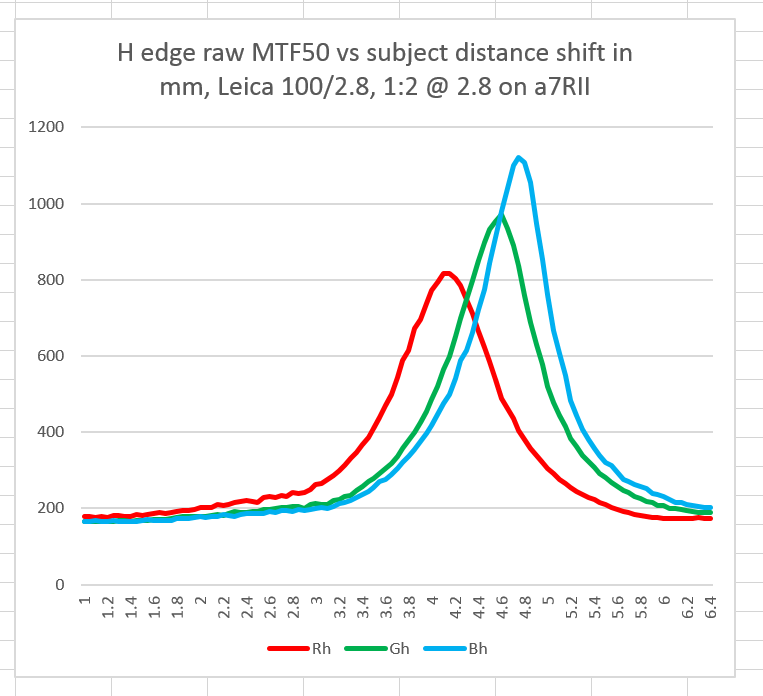
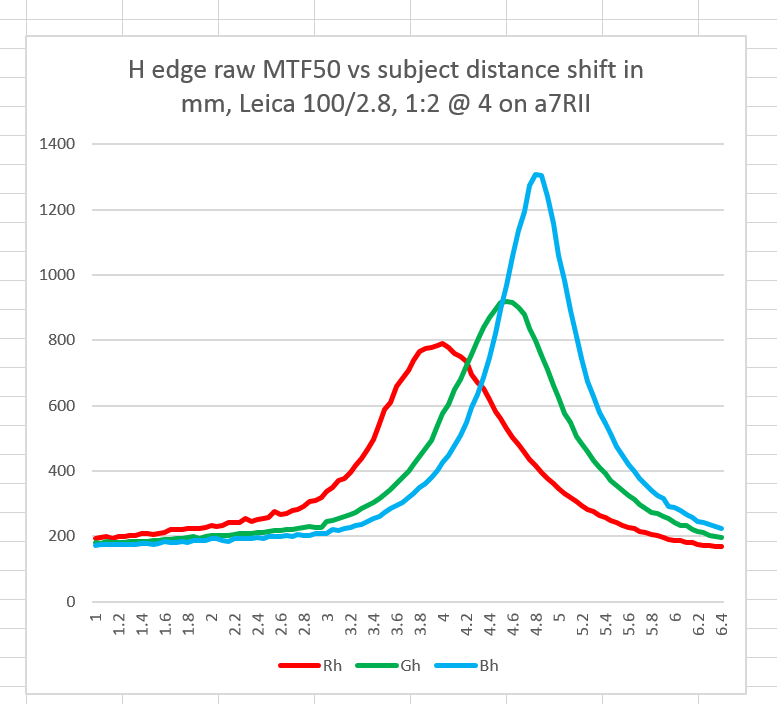

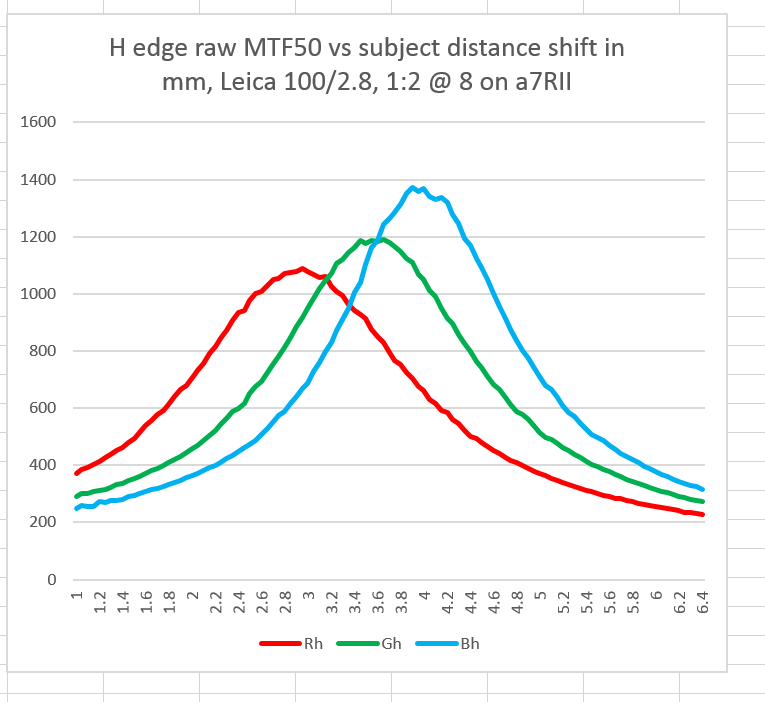
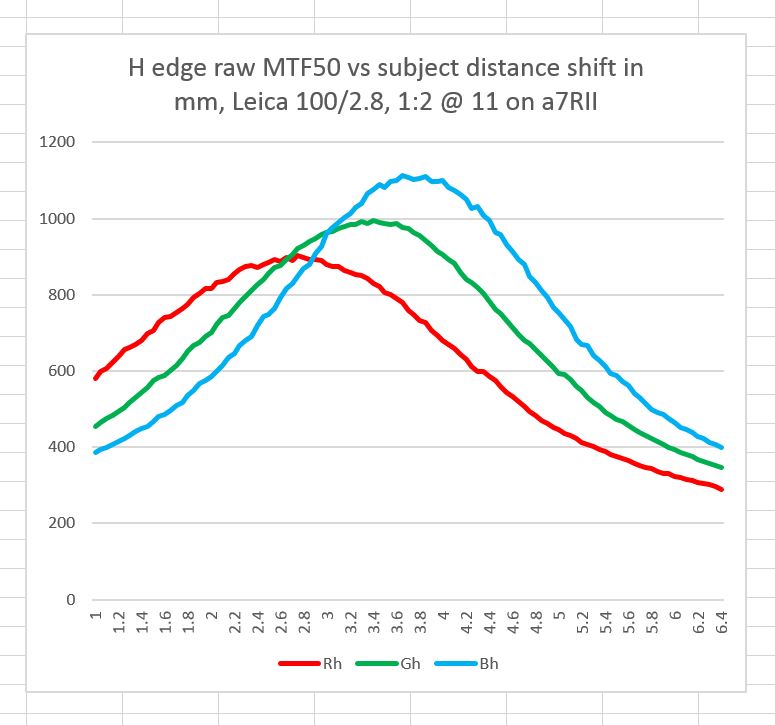
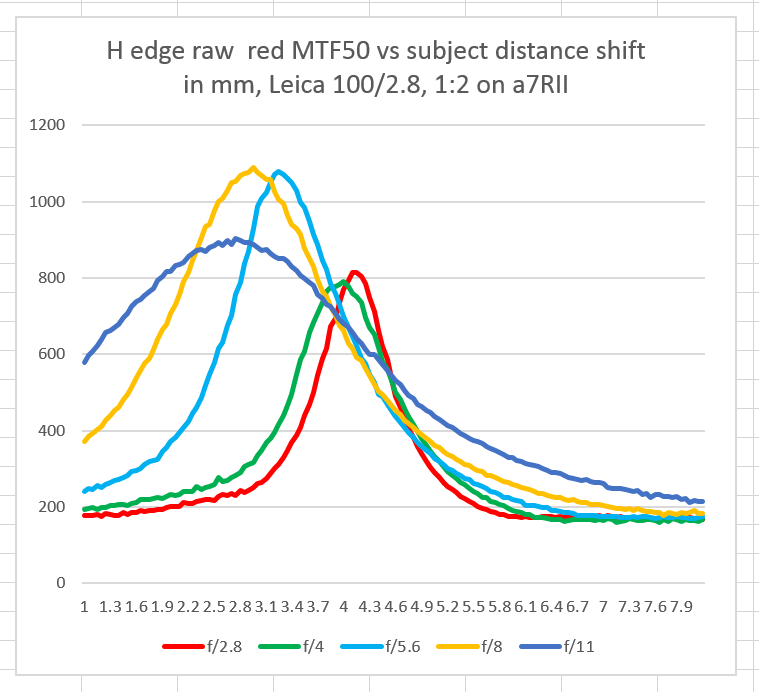
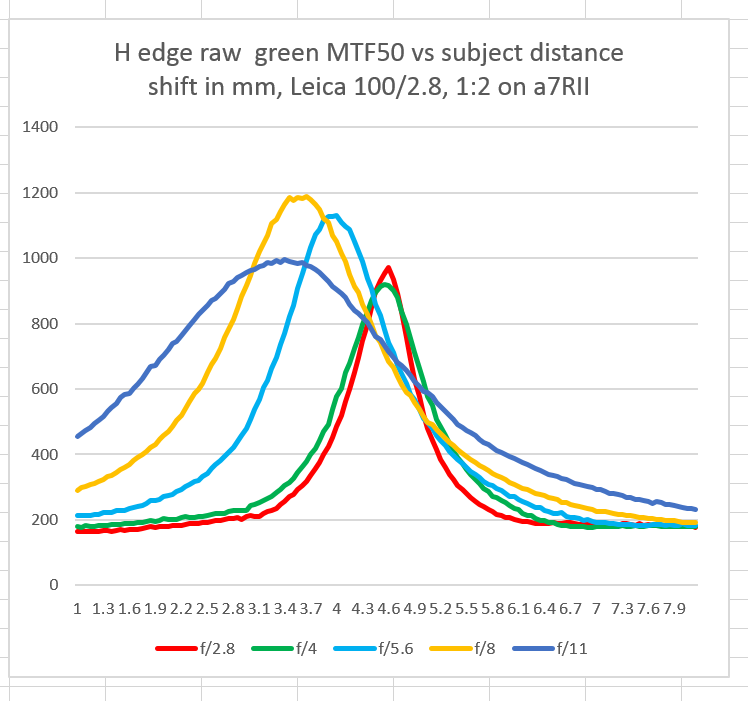

David Braddon-Mitchell says
Hmm results like this make me annoyed with a Famous Blogger and Subscription Reviewer whose work I sometimes enjoy, but who is far to quick to judge. He has been moaning about Sony lenses focussing stopped down recently.
Sure stopped down focussing may a little less accurate in a world with no focus shift. But that’s not the real world.
CarVac says
I learned the focus shift on my lenses by feel and correct for it when manually focusing.
AF is another story, of course.
Jim says
Given that focus shift varies by wavelength, aperture, and distance, I can’t imagine doing that myself. If you can do it, more power to you. Have you conducted tests to find out if you are indeed correcting accurately?
Jim
CarVac says
It’s a first order approximation, only really used at long distance for landscape work through the (optical) viewfinder. Up close I tend to use stopped down focus.
I focus perfectly as I can in magnified live view at a distance at narrow aperture, then open it up and see how much I have to move the focus ring to correct for it. On my Distagon 28/2.8 and Sonnar 85/2.8, it’s about half a millimeter of focus ring movement from f/2.8 to f/8.
I imagine that’s far more focus shift than your lenses have… Which is how I can make a big difference.
Perfect? No. Better? Yes.
The wavelength dependency doesn’t matter because when learning the focus shifts, I judge critical focus at 10x magnification with my eye, which not coincidentally happens to be the same wavelength criteria as how I judge focus on the computer.
That said, for some of my lenses, particularly the aforementioned 28, field curvature dominates the focus shift, though the backwards focus shift actually works in my favor when dealing with the field curvature.
Jack Hogan says
I am curious about why Leica pushes the blue channel vs the green one, well beyond diffraction differences. Doesn’t make sense theoretically. Is it desired or a side effect? Are they after a look?
Federico Ferreres says
Excellent educational article and clearly explained for the semi-layman. Thanks Jim! It’s the first time ever I see a way to visualize LoCA in tests, and this way is very simple and intuitive. Is it possible for someone with just a camera to do tests like these or does one need very expensive equipment?
JimK says
You need a motorized rail. Last time I looked, they were around $600. If your camera has focus bracketing, you can use that instead for the LoCA testing, but I wouldn’t count on the focus shift curves being accurate.